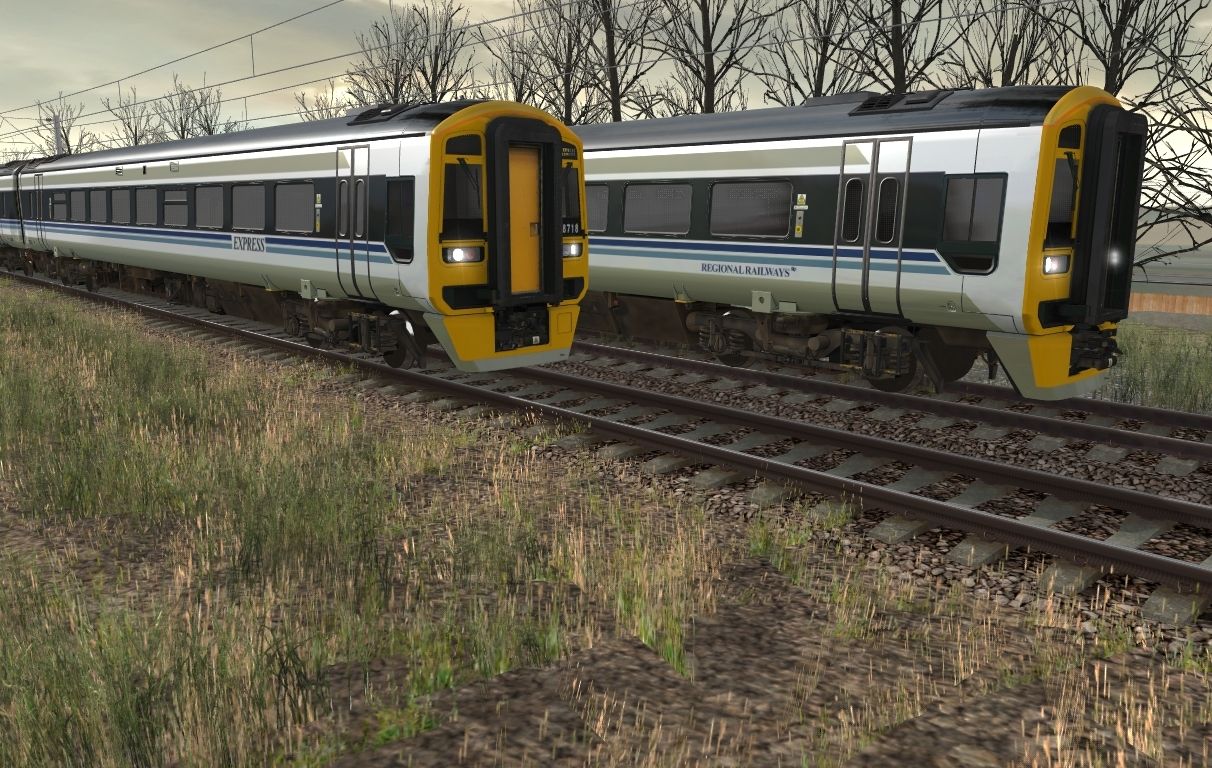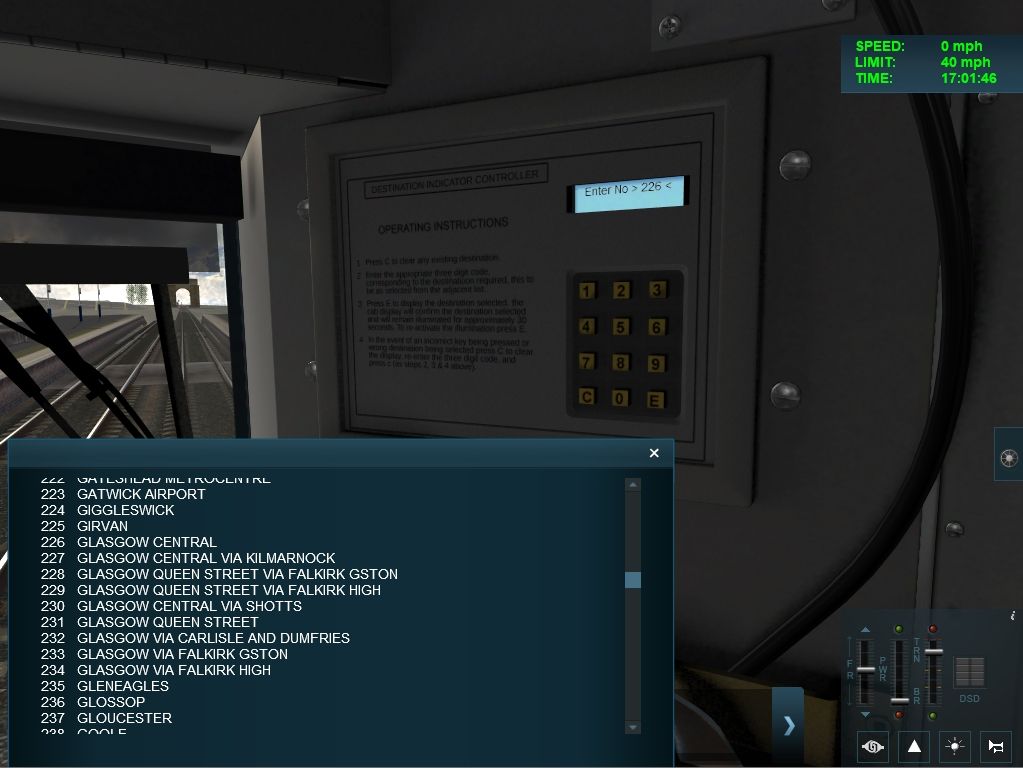Quite simply, the original livery as delivered to B.R. when they were first built (sorry, I haven't got any pictures.) I always felt that it looked really classy, something rather upmarket; although they deteriorated badly internally once the public had defaced and abused them for a few months. Sadly though, like all "Sprinter" trains, they were the start of a new generation of cheap and nasty plastic interiors.So what's your livery of choice then?
That's right. Only in drizzly conditions or very heavy rain/snow (or on contaminated rail surfaces) would Sprinters of any class slip when opening to notch 7 from the off.So even in notch 7 you wouldn't get wheel slip in normal conditions?
To be be honest with you Brendan, I can't remember. Once they started putting stuff in foreign languages (I'm an old fashioned Englishman) instead of psi then a lot of us footplatemen just sort of "switched off." About the only thing I remember in Bar was when we got the Class 56's from Rumania at Saltley and I learnt that we had to have 5 bar in the train pipe - hence that stuck with me that 5 bar was 72.5 psi. I think the reservoir pressures were between 7.8 bar and 9.5 bar (114 psi - 140 psi) but little else sticks with me though, I'm ashamed to say. Nothing was ever that uniform (1 bar, 2 bar, 3 bar etc) with trains though, as you can see from the reservoir pressures, and most drivers only cared about the air pressure required to fill the reservoirs and release the brakes. I dare say there are few drivers around now with my seniority who could remember what the brake cylinder pressures are supposed to be. We knew roughly where the needles should be pointing but, more importantly, we knew instantly from the feeling through the driving seat (just like flying by the seat of your pants) whether the brakes felt right or not. "They" never seemed to choose simple whole numbers for anything, especially when all that decimal crap started coming around. Maybe Dave (Nexusdj) can fill in a bit of technical stuff here with regard to brake cylinder air pressures. He has a great knack of finding the required details.I'm guessing for each brake step the brake cylinder pressures are 1 bar, 2 bar and 3 bar. Do you know if that would be right?
No, sadly not. Once traction power was cut off you had to return the throttle to the closed position before you could take power again. The brake controller would, of course, also have to be returned to the off position before the driver could retake power as normal.Does that mean when braking you could/would just leave the throttle in a particular notch when applying some brake to reduce speed to a certain level, rather than cut the throttle first, and normal power would resume once you released the brakes?
Yes, they're mcb's (miniature circuit breakers.) Anything pointing upwards is "ON", anything pointing downwards usually means you've got trouble. I can't remember the order for the mcb's but maybe a couple of pictures might help:Ah, so all those switches behind the driving position are actually trip switches. I take it they should all be up then?
I actually have those switches modelled but there's a few blanks in the labels. Would you happen to remember what was on all the switch labels? (this trainz content creation lark has turned me into a right little rivet counter)
What's a B.I.S.!

The "Wheel Slip" mcb was not covered and sealed originally. It was modified to stop us drivers from using one of our cheats. In hot weather it wasn't unusual for one of the engines to shut down (or both if you were really unlucky) - most of these events were due to "high water temperature" rather than low radiator water levels. In order to restart the engine the driver would need to place the direction selector into the neutral position. However, if you did that whilst moving you would get an emergency brake application and come to a shuddering halt. Not good. So, as a group (the old B.R. drivers always co-operated with each other) we learnt over a period of time that if the wheel slip mcb tripped, the speedometer immediately stopped working. The next step then was to see if it actually fooled the Unit's elctronics into thinking the Unit was stationary - which, of course, we found out that it did. So, the simple solution to losing an engine enroute was to trip the Wheel Slip mcb, put the Unit in Neutral, restart the engine (not always possible but more times than not it would start,) reselect "forward" on the direction selector and then, finally, reset the Wheel Slip mcb. It was usually enough to get you out of a sticky situation (if you were going up a steep hill or something) but it wasn't a long term solution. Naturally, the boss men didn't like us doing it so... sealed off.

The B.I.S is the "Battery Isolating Switch" which renders the Unit electrically dead if turned to the isolate postion. It is found on the outside of the Class 158 (and all diesel Units to the best of my knowledge.) I've put a red circle around it in the above picture for you. The positions were marked "ON" or "ISOLATE." Top and bottom was Isolate, left and right was On.The selector is a two handled affair with a sort of pointy arrow in the middle at the point of rotation. Whichever label the arrow points at indicates the current selected mode. You can turn the handles either clockwise or anticlockwise. There's no right way or wrong way to turn it. You simply please yourself.

There were also lists of codes (often in different places in most unit's cabs lol!) for the electronic Destination Indicator (below.) Amazingly, you eventually learnt a lot of them without even referring to the list:

I knicked the picture above off the internet so apologies to the original poster.
As for the speedo, yes it only goes up to 100 mph but the bar that stops the needle is further round the guage (I never managed to get the needle that far round though) so that's why I said "about" just short of 105 mph.
Anyway Brendan, I hope that information helps you out. I'm always around at some point so ask and I'll do my best to answer as best I can.
Cheers
Dave






